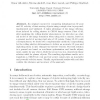Free Online Productivity Tools
i2Speak
i2Symbol
i2OCR
iTex2Img
iWeb2Print
iWeb2Shot
i2Type
iPdf2Split
iPdf2Merge
i2Bopomofo
i2Arabic
i2Style
i2Image
i2PDF
iLatex2Rtf
Sci2ools
ECCV
2006
Springer
2006
Springer
Simultaneous Object Pose and Velocity Computation Using a Single View from a Rolling Shutter Camera
An original concept for computing instantaneous 3D pose and 3D velocity of fast moving objects using a single view is proposed, implemented and validated. It takes advantage of the image deformations induced by rolling shutter in CMOS image sensors. First of all, after analysing the rolling shutter phenomenon, we introduce an original model of the image formation when using such a camera, based on a general model of moving rigid sets of 3D points. Using 2D-3D point correspondences, we derive two complementary methods, compensating for the rolling shutter deformations to deliver an accurate 3D pose and exploiting them to also estimate the full 3D velocity. The first solution is a general one based on non-linear optimization and bundle adjustment, usable for any object, while the second one is a closed-form linear solution valid for planar objects. The resulting algorithms enable us to transform a CMOS low cost and low power camera into an innovative and powerful velocity sensor. Finally...
Accurate 3D Pose | CMOS Image Sensors | Computer Vision | ECCV 2006 | Instantaneous 3D Pose | Powerful Velocity Sensor | Rolling Shutter Deformations |
| Added | 16 Oct 2009 |
| Updated | 16 Oct 2009 |
| Type | Conference |
| Year | 2006 |
| Where | ECCV |
| Authors | Omar Ait-Aider, Nicolas Andreff, Jean-Marc Lavest, Philippe Martinet |
Comments (0)

